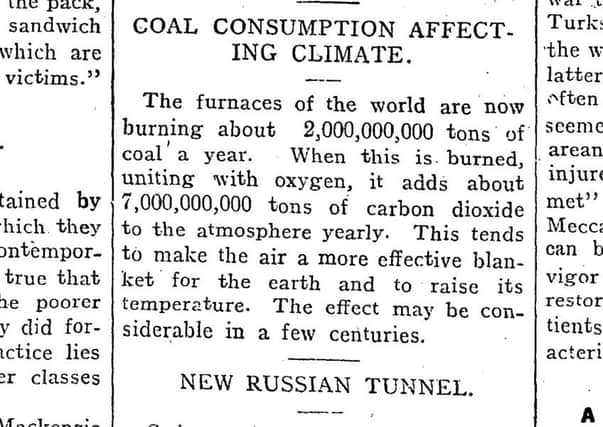Ilona Amos: It's time to learn lessons from the history of climate change


I’m glad to see children today are being taught about it in primary school. I can’t recall when I first became aware of it myself, though I’m pretty sure it was known as global warming. I do remember warnings over the greenhouse effect.
You might be forgiven for thinking the science of climate change is relatively new, but in fact people have been deliberating over the impact of environmental changes on the climate for a very long time – more than two millennia.
Advertisement
Hide AdAdvertisement
Hide AdYou couldn’t get anything past the ancient Greeks. Apparently Theophrastus, a pupil of Aristotle, told how the draining of marshes had made a place more susceptible to freezing, and speculated that lands became warmer when forests were cleared to expose them to sunlight. That was around 300 BC.
More recently, in 1859, scientist John Tyndal began studying the radiative properties of various gases and how fluctuations in water vapour and carbon dioxide affected the climate.
A few years later, Swedish electrochemist Svante Arrhenius became the first person to investigate the effect of doubling the level of atmospheric carbon dioxide effect on the planet’s climate. By 1904 he had become concerned with rapid increases in human-induced carbon emissions, stating: “The slight percentage of carbonic acid in the atmosphere may, by the advances of industry, be changed to a noticeable degree in the course of a few centuries.” He won a Nobel prize, although not for his climate work.
In 1912, New Zealand’s Rodney and Otamatea Times, Waitemata and Kaipara Gazette reported: “The furnaces of the world are now burning about 2,000,000,000 tons of coal a year. When this is burned, uniting with oxygen, it adds about 7,000,000,000 tons of carbon dioxide to the atmosphere yearly. This tends to make the air a more effective blanket for the earth and to raise its temperature. The effect may be considerable in a few countries.”
Until around 1960 most scientists dismissed the notion that humans could significantly affect average global temperatures. Nowadays, we know (though some continue to believe otherwise) that carbon dioxide levels have risen dramatically – faster than Arrhenius predicted.
Research shows CO2 levels were around 200 parts per million (ppm) during the ice ages and around 280 ppm during warmer periods. In 2013, levels surpassed 400 ppm for the first time in recorded history. The global annual temperature has increased at an average rate of 0.07C per decade since the 1880 baseline, and by 0.17C per decade since 1970.
If we need any more convincing, we’ve just experienced the three warmest years on record – all with average temperatures of more than 1C above pre-industrial levels. It’s fast approaching the internationally agreed 2C mark for ‘dangerous’ climate change and frighteningly close to the 1.5C target set in the Paris Agreement, which the Met Office has warned we could smash through within five years.
We’re now witnessing ice caps melting, sea levels rising, oceans becoming more acidic and an increase in extreme weather events across the globe. We really need to take heed of these warnings from our forebears as it we can no longer pass off their predictions as mere hot air.
